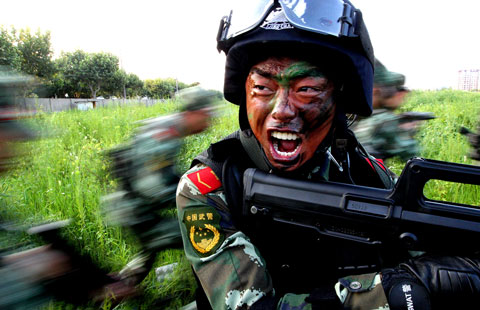
II. Helping Improve People's Livelihood
One of the important objectives of China's foreign assistance is to support other developing countries to reduce poverty and improve the livelihood of their peoples. China prioritizes supporting other developing countries to develop agriculture, enhance education level, improve medical and health services and build public welfare facilities, and provide emergency humanitarian aid when they suffer severe disasters.
1. Promoting Agricultural Development
Agricultural development is crucial to poverty reduction in developing countries. Through establishing agricultural technology demonstration centers, dispatching agricultural experts to provide consultations and conduct technical cooperation, and training technical and managerial personnel on agriculture in other developing countries, China has taken proactive efforts to help other developing countries raise their agricultural productivity to effectively cope with food crises. From 2010 to 2012, China assisted 49 agricultural projects, dispatched over 1,000 agricultural experts to recipient countries, and provided them with a great quantity of machinery, improved varieties of grain, fertilizers and other agricultural materials.
Assisting the establishment of agricultural technology demonstration centers. Such centers provide an important platform for China's foreign assistance in agriculture. From 2010 to 2012, China-assisted agricultural demonstration centers were completed in 17 countries, including Benin, Mozambique, Sudan, Liberia, Rwanda, Laos, and East Timor. China passed on advanced and applicable production technologies to local farmers through experiment, demonstration and training. The demonstration center in Liberia promoted hybrid rice and corn planting in areas of nearly 1,000 hectares, and trained over 1,000 local agricultural researchers and farmers. The demonstration center in Rwanda researched, experimented on and demonstrated the adaptability of paddy rice and fungi in the context of the local traditional agriculture, and provided technical training to women's associations, paddy rice growers' associations and other organizations in Rwanda.
Dispatching senior agricultural experts and expert teams. Chinese agricultural experts took an active part in the agricultural planning of the recipient countries. The expert team dispatched to Benin provided expertise to the drafting of the country's Agricultural Law and Agricultural Administration Law. The expert teams sent to Botswana and Guinea-Bissau participated in the formulation of the two countries' agricultural development plans. Chinese experts assisted recipient countries in promoting their agricultural development. The expert team helped Lesotho with its application to the World Health Organization for FMD (foot-and-mouth disease) free membership. The expert team to Mauritania assisted the country in drawing up the plan for building its central laboratory for agricultural comprehensive analysis and testing. Chinese experts actively disseminated easy-to-learn agricultural techniques suited to the conditions of recipient countries. The expert team to Botswana promoted the use of plastic mulch in crop production. The expert team to Mali devised and promoted the use of iron harrows as a means of intensive cultivation in the paddy fields.
Training technical and managerial personnel on agriculture. Taking the characteristics and actual needs of agricultural development in developing countries into consideration, China provided nearly 300 research and training programs of various forms for almost 7,000 agricultural officials and technicians from the recipient countries. These programs covered a wide range of sectors, including management of crop cultivation, forestry, animal husbandry and fishery, national policymaking on rural development and poverty reduction, food security, and agricultural cooperation among developing countries, and issues concerning the agricultural chain, such as technology dissemination and the processing, storage, marketing and distribution of agricultural products.
2. Improving the Level of Education
From 2010 to 2012, China continuously intensified its efforts of foreign assistance in education by way of constructing and maintaining school buildings, providing teaching facilities, training teachers, offering more government scholarships for foreign students to study in China, and assisting with the development of vocational and technical education, for the purpose of helping other developing countries improve their educational level and support their balanced and equitable development in education.
Improving teaching and learning conditions. China assisted over 80 projects in relation to educational facilities, including the construction and maintenance of primary and secondary schools, universities and colleges as well as libraries, and has effectively improved the teaching and learning conditions in the recipient countries. China provided large amounts of free educational facilities and materials to the recipient countries, including computers, teaching tools, stationery and sports equipment, and established university online education networks and distance education systems. In this way, China facilitated the efforts of recipient countries to diversify their means and expand the coverage of education.
Training teachers. In the three years, China trained over 1,000 educational officials, principals and faculty members from other developing countries by holding over 30 educational training programs, including those for senior administrators of colleges and universities, for higher education management, for vocational education management, for principals and teachers of primary and secondary schools, and for distance education.
Supporting vocational and technical education. Thousands of local people have been trained in the China-assisted Friendship Vocational Training Center in Omdurman. To increase its enrolment, China started the upgrading and expansion project of the center. China took active steps to help the recipient countries develop vocational and technical education. From 2001 to 2012, China dispatched over 400 teachers to Ethiopia to train the local teachers working in agricultural vocational and technical education. A total of 1,800 teachers from agricultural vocational schools and 35,000 agricultural technicians received training.
Increasing government scholarships to foreign students. From 2010 to 2012, the Chinese government assisted 76,845 foreign students to study in China. To promote regional development, China has continuously increased government scholarships to African students and augmented assistance for students from the ASEAN countries and the Pacific island countries to help under-developed countries in these regions develop their human resources.
3. Improving Medical and Health Services
Medical and health care is a major field where China directs its foreign assistance. From 2010 to 2012, China helped recipient countries improve their medical and health services, raise their disease control and prevention ability, and enhance their public health capacity by constructing hospitals, providing medicine and medical equipment, dispatching medical teams, training medical workers and conducting exchanges and cooperation on disease prevention and treatment with other developing countries.
Constructing medical facilities and providing free medical equipment. China assisted about 80 construction projects of medical facilities, including general hospitals, mobile hospitals, health centers, specialist clinics, and traditional Chinese medicine (TCM) centers, which have effectively alleviated the shortage of medical and health facilities in recipient countries. Moreover, China provided them with about 120 batches of medical equipment and medicine, including color Doppler ultrasound machines, CT scanners, automatic biochemical analyzers, maternal and infant monitors, critical surgical instruments, ICU monitors, and MRI scanners as well as drugs against diseases such as malaria and cholera.
Dispatching medical teams. China dispatched 55 medical teams with 3,600 medical workers to nearly 120 medical centers in recipient countries. They trained tens of thousands of local medical staff, which has relieved to a certain extent the shortage of medical services in recipient countries. The training was carried out through demonstrations, lectures, technical courses and academic exchanges, covering such topics as the prevention and treatment of malaria, AIDS, schistosomiasis and other infectious diseases, patient care, the treatment of diabetes and rheumatism, as well as the TCM of acupuncture application, naprapathy, health care methods and Chinese medicines. From 2010 to 2012, more than 100 Chinese medical workers were conferred medals by the recipient countries for their outstanding contributions.
Carrying out Brightness Trip activities. Brightness Trip program was actively carried out in both governmental and non-governmental channels to help other developing countries in the treatment of eye diseases. From 2003, China started to send medical teams to provide free surgery for patients with eye diseases in the Democratic People's Republic of Korea, Cambodia, Bangladesh, Vietnam, Pakistan and other Asian countries. In November 2010, a Chinese Brightness Trip medical team arrived in Africa for the first time and carried out operations for over 1,000 cataract patients in countries including Zimbabwe, Malawi, Mozambique and Sudan.
Assisting the prevention and control of infectious diseases. From 2010 to 2012, China provided 60 batches of antimalarial medicine, H1N1 influenza vaccine and cholera vaccine free of charge to other developing countries and held training in the prevention and control of infectious diseases, the expenditure for this purpose accumulating to RMB200 million. In 2007, China and the Comoros launched a cooperation program of treating malaria with an artemisinin compound, an effective antimalarial drug, which helped the Comorian island of Moheli reduce its incidence of malaria by 90%. From 2010 to 2012, while making further progress in Moheli, China started promoting the program on the Comorian island of Anjoyan.
4. Building Public Welfare Facilities
To support other developing countries in improving their people's livelihood and organizing public activities, China actively assisted the construction of urban and rural public welfare facilities, affordable housing and social activity venues, provided relevant equipment and materials, and conducted technical cooperation on operation and management.
Carrying out well-drilling and water-supply projects. China undertook 29 well-drilling and water-supply projects in other developing countries, and drilled over 600 wells. Despite tough natural conditions and the threat of epidemics and terrorism, senior hydrogeologists and engineering geologists from China helped the recipient countries drill wells and undertake water-supply projects. China helped drill 200 fresh water wells in Kara and Centrale of Togo respectively and 38 wells in Darfur, Sudan and Kator of Juba, South Sudan, all of which were equipped with submersible pumps and generator sets. The China-assisted water-supply project in Zinder, Niger has solved the problem of drinking water for hundreds of thousands of local residents.
Improving people's living conditions. China assisted 80 residential housing and affordable housing projects in other developing countries, totaling about 600,000 square meters in floor space. China's architects and engineers gave full consideration to the living habits and environmental features of the recipient countries in both external and interior design, and exercised strict quality control while making efforts to reduce costs, for the purpose of providing comfortable and endurable houses to local residents.
Assisting the construction of public facilities. China assisted 86 construction projects of public cultural venues, sports venues, office buildings and conference centers in other developing countries. These projects helped enrich local residents' cultural and recreational life, improve the working conditions of local governments, and create a better cityscape. China assisted the rehabilitation of Sri Lanka's Bandaranaike Memorial International Conference Hall, which was a gift from China in the 1970s and took on new dimensions four decades later. China funded the construction of Gabon's 40,000-seat stadium Stade d' Angondje, which hosted the competition final and closing ceremony of the 28th Africa Cup of Nations in 2012. China assisted the construction of the 20,000-square-meter Grand National Theater in Senegal, one of the largest theaters in Africa.
5. Humanitarian Aid
Over the past few years, the world has been frequently hit by severe natural disasters caused by earthquakes, hurricanes, floods and droughts as well as humanitarian crises caused by wars, and many countries have suffered serious casualties and property losses. China has made quick response to the appeals of the international community by providing relief materials or cash aid and dispatching rescue and medical teams as needed, to help the victim countries with disaster relief and post-disaster reconstruction.
Providing emergency relief materials or cash aid. From 2010 to 2012, the Chinese government provided RMB1.2 billion worth of emergency relief materials in some 50 batches, including tents, blankets, emergency lights, generators, fuel oil, food, medicine and water filters, to countries affected by natural disasters or humanitarian crises, such as the earthquake in Haiti, floods in Cambodia, earthquake in Myanmar, floods in Pakistan, hurricane in Cuba, the war in Libya, and the turmoil in Syria. In addition, China provided cash aid totaling RMB300 million.
Assisting African countries in coping with the food crisis. In 2011 and 2012, the Horn of Africa and the Sahel were stricken by severe droughts and over 30 million people were faced with a serious food shortage. In 2011, the Chinese government provided on three occasions a total of RMB440 million worth of emergency food aid to the countries of the Horn of Africa, such as Ethiopia, Kenya, Djibouti and Somali. In 2012, the Chinese government provided RMB70 million worth of emergency food aid to Chad, Mali, Niger and other countries in the Sahel.
Supporting post-disaster reconstruction. In 2010, Pakistan was hit by a severe flood rarely seen in history. The Chinese government promptly carried out rescue work in all aspects and through multiple channels, participated in post-flood reconstruction by helping the victims and rebuilding transportation infrastructure as the country requested. China also provided cash aid to support Pakistan government's compensation packages for victims, and undertook the restoration project of the 340-kilometer national highway network destroyed in the flood-stricken areas, enabling 150 million people to have access to the traffic network. In March 2012, a series of blasts occurred in the north of Brazzaville, the capital of the Republic of Congo. China assisted the construction of settlements for people displaced from their homes and actively supported reconstruction after the explosions.
Helping improve disaster prevention and relief capacity. China helped recipient countries enhance their emergency rescue, disaster prevention and relief capacity by ways of providing materials and training. Over the three years, China provided over 10 batches of rescue vehicles and equipment, and held 30 training programs on disaster prevention and relief for other developing countries, sharing experience with over 700 officials and technicians.








